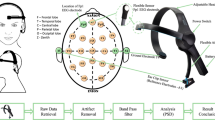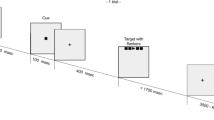Summary
Topographic EEG was performed in 17 DSM-III-R schizophrenic patients and in 15 sex- and agematched healthy controls. Eleven patients were firstonset (neuroleptic naive) schizophrenics. EEG band power was compared with psychopathology, neuropsychology and neurological soft signs. The EEG was recorded at 14 topographic locations monopolarly and movements of the eye and of the lid were monitored by two bipolar electro-oculogram (EOG) derivations, one vertical and one horizontal. A multivariate correction of EOG artefacts was performed based on regression analysis with respect to EOG channels. Schizophrenic patients showed higher mean and median power in most bands. These differences were most marked in the delta band, in the fast alpha and beta bands, in particular at left frontal sites. Delta power at F7 was by far the best separating variable between schizophrenics and controls in a discriminant analysis. Significant positive correlations were found between the Brief Psychiatric Rating Scale scores “Anxiety-depression” and “Activation” and power in the fast bands and negative ones between “Anergia” and the beta bands. Positive significant correlations emerged between the total score in the Negative Symptoms Rating Scale and the amount of delta power, predominantly over the temporal region. Impairment in the Luria-Nebraska neuropsychological scores “Rhythm” and “Memory” correlated highly significantly with EEG band power. No correlations were found between neurological soft signs and EEG band power. Our results are in line with the hypothesis of a hypofrontality in schizophrenia. It is unlikely that these findings are an artefact of prior psychiatric treatment, as they were also observed in firstonset, neuroleptic naive schizophrenics. Moreover, our data suggest that these abnormalities are of clinical and functional relevance, as they correlated significantly with psychopathological and neuropsychological parameters.
Similar content being viewed by others
References
Abrams R, Taylor MA (1981) Cognitive dysfunction in schizophrenia, affective disorder and organic brain disease. Br J Psychiatry 139:190–194
Buchsbaum MS, Ingvar DH, Kessler T, Water RN, Cappelletti J, Kammen DP van, King AC, Johnson JL, Manning RG, Flynn RW, Mann LS, Bunney WE, Sokoloff L (1982) Cerebral glucography with positron tomography: Use in normal subjects and in patients with schizophrenia. Arch Gen Psychiatry 39: 251–259
Flor-Henry P, Yeudall LT (1979) Neuropsychological investigation of schizophrenia and manic-depressive psychoses. In: Gruzelier J, Flor-Henry P (eds) Hemispheric asymmetries of function in psychopathology. Elsevier North Holland, Amsterdam, pp 341–362
Gasser T, Bächer T, Möcks J (1982) Transformations towards the normal distribution of broad bans spectrum parameters of the EEG. Electroencephalogr Clin Neurophysiol 52:119–124
Gasser T, Sroka L, Möcks J (1986) The correction of EOG artifacts by frequency dependent and frequency independent methods. Psychophysiology 23:704–712
Gasser T, Ziegler P, Gattaz WF (1992) The deletereous effect of ocular artifacts on the quantitative EEG, and a remedy. Eur Arch Psychiatry Clin Neurosci 241:352–356
Gruzelier JH (1991) Brain localization and neuropsychology in schizophrenia: syndrome and neurodevelopmental implications. In: Häfner H, Gattaz WF (eds) Search for the causes of schizophrenia. Springer, Berlin Heidelberg New York, pp 301–320
Guenther W, Breitling D, Banquet JP, Marcie P, Rondot P (1986) EEG mapping of left hemisphere dysfunction during motor performance in schizophrenia. Biol Psychiatry 21:249–262
Guich SM, Buchsbaum MS, Burgwald L, Wu J, Haier R, Asarnow R, Nuechterlein K, Potkin S (1989) Effect of attention on frontal distribution of delta activity and cerebral metabolic rate in schizophrenia. Schizophr Res 2:439–448
Heinrichs DW, Buchanan RW (1988) Significance and meaning of neurological signs in schizophrenia. Am J Psychiatry 145:11–18
Iager AC, Kirch DG, Wyatt RJ (1985) A negative symptom rating scale. Psychiatry Res 16:27–36
Ingvar DH, Franzen G (1974) Abnormalities of cerebral blood flow distribution in patients with chronic schizophrenia. Acta Psychiatr Scand 50:425–462
Itil TM (1977) Qualitative and quantitative EEG findings in schizophrenia. Schizophr Bull 3:61–79
Itil TM, Saletu B, Davis S (1972) EEG findings in chronic schizophrenics based on digital computer period analysis and analog power spectra. Biol Psychiatry 5:1–13
Karson CN (1983) Spontaneous blink rates and dopaminergic systems. Brain 106:643–653
Karson CN, Coppola R, Morihisa JM, Weinberger DR (1987) Computed electroencephalographic activity mapping in schizophrenia: the resting state reconsidered. Arch Gen Psychiatry 44:514–517
Karson CN, Coppola R, Daniel DG, Weinberger DR (1988a) Computerized EEG in schizophrenia. Schizophr Bull 14:193–197
Karson CN, Goldberg TE, Coppola R (1988b) Preliminary studies, of alpha rhythm and neuropsychological impairment in schizophrenia. Schizophr Res 1:399–403
Kennard MA (1960) Value of equivocal signs in neurological diagnosis. Neurology 10:753–764
Matsue Y, Okuma T, Hidemitsu S, Aneha S, Ueno T, Hideaki C, Matsuoka H (1986) Saccadic eye-movements in tracking, fixation, and rest in schizophrenic and normal subjects. Biol Psychiatry 21:382–389
Möcks J, Gasser T (1984) How to select epochs of the EEG at rest for quantitative analysis. Electroencephalogr Clin Neurophysiol 58:89–92
Möcks J, Gasser T, Sroka L (1989) Approaches to correcting EOG artifacts. J Psychophysiol 3:21–26
Morihisa JM, Duffy FH, Wyatt RJ (1983) Brain electrical activity mapping (BEAM) in schizophrenic patients. Arch Gen Psychiatry 40:719–728
Morstyn R, Duffy FH, McCarley RW (1983) Altered topography of EEG spectral content in schizophrenia. Electroencephalogr Clin Neurophysiol 38:263–271
Mosher LR, Pollin W, Stabenau JR (1971) Identical twins discordant for schizophrenia. Arch Gen Psychiatry 24:422–430
Nakagawa M, Takeda K, Kakimoto Y (1991) Characteristic distribution of alpha 2 wave in electroencephaolograms of schizophrenic patients during discriminative tasks: support for the hypofrontality hypothesis of schizophrenia. Acta Psychiatr Scand 83:105–114
Paulman RG, Devous MD, Gregory RR, Herman JH, Jennings L, Bonte FJ, Nasrallah HA, Raese JD (1990) Hypofrontality and cognitive impairment in schizophrenia: dynamic single-photon tomography and neuropsychological assessment of schizophrenic brain function. Biol Psychiatry 27:377–399
Quitkin F, Rifkin A, Klein DF (1976) Neurologic soft signs in schizophrenia and character disorders. Arch Gen Psychiatry 33:845–853
Ray W, Cole HW (1985) EEG alpha reflects attentional demands, and beta activity reflects emotional and cognitive processes. Science 228:750–752
Sagawa K, Kawakatsu S, Komatani A, Totsuka S (1990) Frontality, laterality, and cortical-subcortical gradient of cerebral blood flow in schizophrenia: relationship to symptoms and neuropsychological functions. Neuropsychobiology 24:1–7
Seidman LJ (1983) Schizophrenia and brain dysfunction: an intergration of recent neurodiagnostic findings. Psychol Bull 94: 195–238
Shagass C (1991) EEG studies of schizophrenia. In: Steinhauer SR, Gruzelier JH, Zubin J (eds) Handbook of schizophrenia, vol 5. Neuropsychology, psychophysiology and information processing. Elsevier, New York, pp 39–69
Taylor MA, Greenspan B, Abrams R (1979) Lateralized neuropsychological dysfunction in affective disorder and schizophrenia. Am J Psychiatr 136:1031–1034
Torrey EF (1980) Neurological abnormalities in schizophrenic patients. Biol Psychiatry 15:381–388
Williamson PC, Kutcher SP, Cooper PW, Snow WG, Szalai JP, Kaye H, Morrison SL, Willinsky RA, Mamelak M (1989) Psychological topographic EEG, and CT scan correlates of frontal lobe function in schizophrenia. Psychiatry Res 29:137–149
Author information
Authors and Affiliations
Rights and permissions
About this article
Cite this article
Gattaz, W.F., Mayer, S., Ziegler, P. et al. Hypofrontality on topographic EEG in schizophrenia. Eur Arch Psychiatry Clin Nuerosci 241, 328–332 (1992). https://doi.org/10.1007/BF02191956
Received:
Issue Date:
DOI: https://doi.org/10.1007/BF02191956




